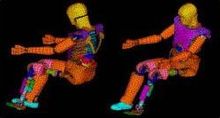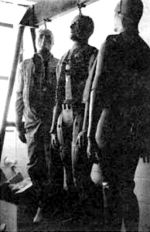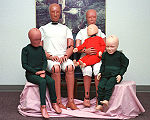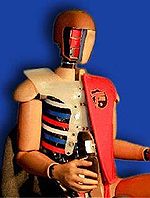- Crash test dummy
-
For the band, see Crash Test Dummies. For the series of toys, see The Incredible Crash Dummies.
 Dummy in a Hyundai Tucson before a crash test
Dummy in a Hyundai Tucson before a crash test
Crash test dummies are full-scale anthropomorphic test devices (ATD) that simulate the dimensions, weight proportions and articulation of the human body, and are usually instrumented to record data about the dynamic behavior of the ATD in simulated vehicle impacts.[1] This data can include variables such as velocity of impact, crushing force, bending, folding, or torque of the body, and deceleration rates during a collision for use in crash tests.
For the purpose of U.S. regulation and Global Technical Regulations and for clear communication in safety and seating design,[2] dummies carry specifically designated reference points, such as the H-point; these are also used, for example, in automotive design.
Crash test dummies remain indispensable in the development of and ergonomics in all types of vehicles, from automobiles to aircraft.
Contents
Testing
On August 31, 1869, Mary Ward became the first recorded victim of a steam-powered automobile accident; Karl Benz had not yet invented the gasoline-powered automobile (1886). Ward, of Parsonstown, Ireland, was thrown out of a motor vehicle and killed.[3] Thirty years later, on September 13, 1899, Henry Bliss became North America's first motor vehicle fatality when hit while stepping off a New York City trolley. Since then, over 20 million people worldwide have died due to motor vehicle accidents.[improper synthesis?]
The need for a means of analyzing and mitigating the effects of motor vehicle accidents on humans was felt soon after commercial production of automobiles began in the late 1890s, and by the 1930s, when the automobile became a common part of daily life and the number of motor vehicle deaths was rising. Death rates had surpassed 15.6 fatalities per 100 million vehicle-miles and were continuing to climb.[citation needed]
In 1930, the interior of a car featured Dashboards of rigid metal, non-collapsible steering columns — and protruding knobs, buttons, and levers. Without seat belts, passengers in a frontal collision could be hurled against the interior of the automobile or through the windshield. The vehicle body itself was rigid, and impact forces were transmitted directly to the vehicle occupants. As late as the 1950s, car manufacturers were on public record as saying that vehicle accidents simply could not be made survivable because the forces in a crash were too great.[citation needed]
Cadaver testing
Detroit's Wayne State University was the first to begin serious work on collecting data on the effects of high-speed collisions on the human body. In the late 1930s there was no reliable data on how the human body responds to the sudden, violent forces acting on it in an automobile accident. Furthermore, no effective tools existed to measure such responses. Biomechanics was a field barely in its infancy. It was therefore necessary to employ two types of test subjects in order to develop initial data sets.
The first test subjects were human cadavers. They were used to obtain fundamental information about the human body's ability to withstand the crushing and tearing forces typically experienced in a high-speed accident. To such an end, steel ball bearings were dropped on skulls, and bodies were dumped down unused elevator shafts onto steel plates. Cadavers fitted with crude accelerometers were strapped into automobiles and subjected to head-on collisions and vehicle rollovers.
Albert King's 1995 Journal of Trauma article, "Humanitarian Benefits of Cadaver Research on Injury Prevention", clearly states the value in human lives saved as a result of cadaver research. King's calculations indicate that as a result of design changes implemented up to 1987, cadaver research has since saved 8500 lives annually. He notes that for every cadaver used, each year 61 people survive due to wearing seat belts, 147 live due to air bags, and 68 survive windshield impact.
However, work with cadavers presented almost as many problems as it resolved. Not only were there the moral and ethical issues related to working with the dead, but there were also research concerns. The majority of cadavers available were older White adults who had died non-violent deaths; they did not represent a demographic cross-section of accident victims. Deceased accident victims could not be employed because any data that might be collected from such experimental subjects would be compromised by the cadaver's previous injuries. Since no two cadavers are the same, and since any specific part of a cadaver could only be used once, it was extremely difficult to achieve reliable comparison data. In addition, child cadavers were not only difficult to obtain, but both legal and public opinion made them effectively unusable. Moreover, as crash testing became more routine, suitable cadavers became increasingly scarce. As a result, biometric data were limited in extent and skewed toward the older males.
Volunteer testing
Some researchers took it upon themselves to serve as crash test dummies. Colonel John Paul Stapp USAF propelled himself over 100 km/h on a rocket sled and stopped in 1.4 seconds.[4] Lawrence Patrick, then a professor at Wayne State University, endured some 400 rides on a rocket sled in order to test the effects of rapid deceleration on the human body. He and his students allowed themselves to be smashed in the chest with heavy metal pendulums, impacted in the face by pneumatically driven rotary hammers, and sprayed with shattered glass to simulate window implosion.[5] While admitting that it made him "a little sore", Patrick has said that the research he and his students conducted was seminal in developing mathematical models against which further research could be compared. But while data from live testing was valuable, human subjects could not withstand tests which went past a certain degree of physical injury. To gather information about the causes and prevention of injuries and fatalities would require a different kind of subject.
Animal testing
By the mid-1950s, the bulk of the information cadaver testing could provide had been harvested. It was also necessary to collect data on accident survivability, research for which cadavers were woefully inadequate. In concert with the shortage of cadavers, this need forced researchers to seek other models. A description by Mary Roach of the Eighth Stapp Car Crash and Field Demonstration Conference shows the direction in which research had begun to move. "We saw chimpanzees riding rocket sleds, a bear on an impact swing...We observed a pig, anesthetized and placed in a sitting position on the swing in the harness, crashed into a deep-dish steering wheel at about 10 mph."[6]
One important research objective which could not be achieved with either cadavers or live humans was a means of reducing the injuries caused by impalement on the steering column. By 1964, over a million fatalities resulting from steering wheel impact had been recorded, a significant percentage of all fatalities; the introduction by General Motors in the early 1960s of the collapsible steering column cut the risk of steering-wheel death by fifty percent. The most commonly used animal subjects in cabin-collision studies were pigs, primarily because their internal structure is similar to a human's. Pigs can also be placed in a vehicle in a good approximation of a seated human.
The ability to sit upright was an important requirement for test animals in order that another common fatal injury among human victims, decapitation, could be studied. Additionally, it was important for researchers to be able to determine to what extent cabin design needed to be modified to ensure optimal survival circumstances. For instance, a dashboard with too little padding or padding which was too stiff or too soft would not significantly reduce head injury over a dash with no padding at all. While knobs, levers, and buttons are essential in the operation of a vehicle, which design modifications would best ensure that these elements did not tear or puncture victims in a crash. Rear-view mirror impact is a significant occurrence in a frontal collision; how should a mirror be built so that it is both rigid enough to perform its task and yet of low injury risk if struck.
While work with cadavers had aroused some opposition, primarily from religious institutions, it was grudgingly accepted because the dead, being dead, felt no pain, and the indignity of their situations was directly related to easing the pain of the living. Animal research, on the other hand, aroused much greater passion. Animal rights groups such as the ASPCA were vehement in their protest, and while researchers such as Patrick supported animal testing because of its ability to produce reliable, applicable data, there was nonetheless a strong ethical unease about this process.
Although animal test data were still more easily obtained than cadaver data, the fact that animals were not people and the difficulty of employing adequate internal instrumentation limited their usefulness. Animal testing is no longer practiced by any of the major automobile makers; General Motors discontinued live testing in 1993 and other manufacturers followed suit shortly thereafter.
Dummy evolution
 Sierra Sam tested ejection seats.
Sierra Sam tested ejection seats.
The information gleaned from cadaver research and animal studies had already been put to some use in the construction of human simulacra as early as 1949, when "Sierra Sam"[7] was created by Samuel W. Alderson at his Alderson Research Labs (ARL) and Sierra Engineering Co. to test aircraft ejection seats, aviation helmets[8] and pilot restraint harnesses. This testing involved the use of high acceleration to 1000 km/h (600 mph) rocket sleds, beyond the capability of human volunteers to tolerate. In the early 1950s, Alderson and Grumman produced a dummy which was used to conduct crash tests in both motor vehicles and aircraft.
Alderson went on to produce what it called the VIP-50 series, built specifically for General Motors and Ford, but which was also adopted by the National Bureau of Standards. Sierra followed up with a competitor dummy, a model it called "Sierra Stan," but GM, who had taken over the impetus in developing a reliable and durable dummy, found neither model satisfied its needs. GM engineers decided to combine the best features of the VIP series and Sierra Stan, and so in 1971 Hybrid I was born. Hybrid I was what is known as a "50th percentile male" dummy. That is to say, it modeled an average male in height, mass, and proportion. The original "Sierra Sam" was a 95th percentile male dummy (heavier and taller than 95% of human males). In cooperation with the Society of Automotive Engineers (SAE), GM shared this design, and a subsequent 5th percentile female dummy, with its competitors.
Since then, considerable work has gone into creating more and more sophisticated dummies.[9] Hybrid II was introduced in 1972, with improved shoulder, spine, and knee responses, and more rigorous documentation. Hybrid II became the first dummy to comply with the American Federal Motor Vehicle Safety Standard (FMVSS) for testing of automotive lap and shoulder belts. In 1973, a 50th percentile male dummy was released, and the National Highway Transportation Safety Administration (NHTSA)[10] undertook an agreement with General Motors to produce a model exceeding Hybrid II's performance in a number of specific areas.[11]
Though a great improvement over cadavers for standardized testing purposes, Hybrid I and Hybrid II were still very crude, and their use was limited to developing and testing seat belt designs. A dummy was needed which would allow researchers to explore injury-reduction strategies. It was this need that pushed GM researchers to develop the current Hybrid line, the Hybrid III family of crash test dummies.
Hybrid III family
Hybrid III, the 50th percentile male dummy which made its first appearance in 1976, is the familiar crash test dummy, and he is now a family man. If he could stand upright, he would be 175 cm (5'9") tall and would have a mass of 77 kg (170 lb). He occupies the driver's seat in all the Insurance Institute for Highway Safety (IIHS)[12] 65 km/h (40 mph) offset frontal crash tests. He is joined by a "big brother", the 95th percentile Hybrid III, at 188 cm (6 ft 2 in) and 100 kg (223 lb). Ms. Hybrid III is a 5th percentile female dummy, at a diminutive 152 cm (5 ft) tall and 50 kg (110 lb).[13] The three Hybrid III child dummies represent a ten year old, 21 kg (47 lb) six year old, and a 15 kg (33 lb) three year old. The child models are very recent additions to the crash test dummy family; because so little hard data are available on the effects of accidents on children, and such data are very difficult to obtain, these models are based in large part on estimates and approximations. The primary benefit provided by the Hybrid III is improved neck response in forward flexion and head rotation that better simulates the human.[14]
Testing procedure
Every Hybrid III undergoes calibration prior to a crash test. Its head is removed and is dropped from 40 centimetres to test calibrate the head instrumentation. Then the head and neck are reattached, set in motion, and stopped abruptly to check for proper neck flexure. Hybrids wear chamois leather skin; the knees are struck with a metal probe to check for proper puncture. Finally, the head and neck are attached to the body, which is attached to a test platform and struck violently in the chest by a heavy pendulum to ensure that the ribs bend and flex as they should.
When the dummy has been determined to be ready for testing, and calibration marks are fastened to the side of the head to aid researchers when slow-motion films are reviewed later. The dummy is then placed inside the test vehicle, set to seating position and then marked on either the head and knees. Up to fifty-eight data channels located in all parts of the Hybrid III, from the head to the ankle, record between 30 000 and 35 000 data items in a typical 100–150 millisecond crash. Recorded in a temporary data repository in the dummy's chest, these data are downloaded to computer once the test is complete.
Because the Hybrid is a standardized data collection device, any part of a particular Hybrid type is interchangeable with any other. Not only can one dummy be tested several times, but if a part should fail, it can be replaced with a new part. A fully instrumented dummy is worth about €150 000.[15]
Hybrid's successors
Hybrid IIIs are designed to research the effects of frontal impacts, and are less valuable in assessing the effects of other sorts of impacts, such as side impacts, rear impacts, or rollovers. After head-on collisions, the most common severe injury accident is the side impact.
The SID (Side Impact Dummy) family of test dummies has been designed to measure rib, spine, and internal organ effects in side collisions. It also assesses spine and rib deceleration and compression of the chest cavity. SID is the US government testing standard, EuroSID is used in Europe to ensure compliance with safety standards, and SID II(s) represents a 5th percentile female. BioSID is a more sophisticated version of SID and EuroSID, but is not used in a regulatory capacity. The WorldSID is a project to develop a new generation of dummy under the International Organization for Standardization.[16]
BioRID is a dummy designed to assess the effects of a rear impact. Its primary purpose is to research Whiplash, and to aid designers in developing effective head and neck restraints. BioRID is more sophisticated in its spinal construction than Hybrid; 24 vertebra simulators allow BioRID to assume a much more natural seating posture, and to demonstrate the neck movement and configuration seen in rear-end collisions.
CRABI is a child dummy used to evaluate the effectiveness of child restraint devices including seat belts and air bags. There are three models of the CRABI, representing 18-month, 12-month, and 6-month old children.
THOR is an advanced 50th percentile male dummy. The successor of Hybrid III, THOR has a more humanlike spine and pelvis, and its face contains a number of sensors which allow analysis of facial impacts to an accuracy currently unobtainable with other dummies. THOR's range of sensors is also greater in quantity and sensitivity than those of Hybrid III.
See also
- Car accident
- Car safety
- Crash test
- Crashworthiness
- Euro NCAP
- Buster - Mythbusters
- Safety car
- Seat belt legislation
- Harold Mertz
- The Incredible Crash Dummies
Footnotes
- ^ Anthropomorphic Test Dummies for Crash and Escape System Testing - AGARD Advisory Report 330 (1996)
- ^ "NHTSA's Activities under the United Nations for Europe 1998 Global Agreement: Head Restraints, Docket NHTSA-2008-001600001". NHTSA. http://www.scribd.com/doc/2752327/Notice-Activities-Under-the-United-Nations-Economic-Commission-for-Europe-1998-Global-Agreement-Head-Restraints.
- ^ "Mary Ward 1827–1869". Famous Offaly People. Offaly Historical & Archaeological Society. Archived from the original on January 5, 2006. http://web.archive.org/web/20060105215309/http://www.offalyhistory.com/content/reading_resources/famous_people/ward_mary.htm. Retrieved April 25, 2006.
- ^ 'Fastest Man on Earth,' Col. John Paul Stapp, Dies at 89 (March 1, 2000). Retrieved April 18, 2006.
- ^ Roach, Mary (November 19, 1999). I was a human crash-test dummy. Salon.com. Retrieved November 29, 2007.
- ^ I was a human crash-test dummy (November 19, 1999).
- ^ "Sierra Sam" Anthropomorphic Dummy
- ^ Evaluation of Sierra Engineering Co. Lightweight Helmet
- ^ The History of Crash Test Dummies
- ^ "NHTSA". http://www.nhtsa.dot.gov.
- ^ NHTSA 49 CFR 572.31 Subpart E—Hybrid III Test Dummy
- ^ "New HLDI study: Texting laws don't reduce crashes". iihs.org. September 28, 2010. http://www.iihs.org. Retrieved 21 October 2010.
- ^ Mello, Tara Baukus (December 5, 2000).The Female Dummy: No Brains, But A Real Lifesaver. Retrieved April 18, 2006.
- ^ Hybrid II and Hybrid III Dummy Neck Properties for Computer Modeling (February 1992)
- ^ How the Test are done (19 March 2003). Retrieved April 18, 2006.
- ^ Anthropometry for WorldSID
References
- "Anatomy of a Crash-Test Dummy", IEEE Spectrum, October 2007
- History of Crash Dummies
- How the dead have helped the living
- I was a human crash test dummy
- The Female Crash Test Dummy She May Not Have a Brain, but She Could Save Your Life
- The "Sierra Sam" Story
- Meet 50th Percentile Hybrid III
- Biomechanics and the Cyberhuman
- It's Smart to be a Dummy
- Pregnant crash test dummy
- Roach, Mary (2003). Stiff: The Curious Lives of Human Cadavers. New York: W.W. Norton & Co.. ISBN 0-393-05093-9.
- King AI, Viano DC, Mizeres N, States JD (1995). "Humanitarian benefits of cadaver research on injury prevention". J Trauma Injury Infect Crit Care 38 (4): 564–569. doi:10.1097/00005373-199504000-00016.
Categories:- Dummies and mannequins
- Transport safety
Wikimedia Foundation. 2010.




